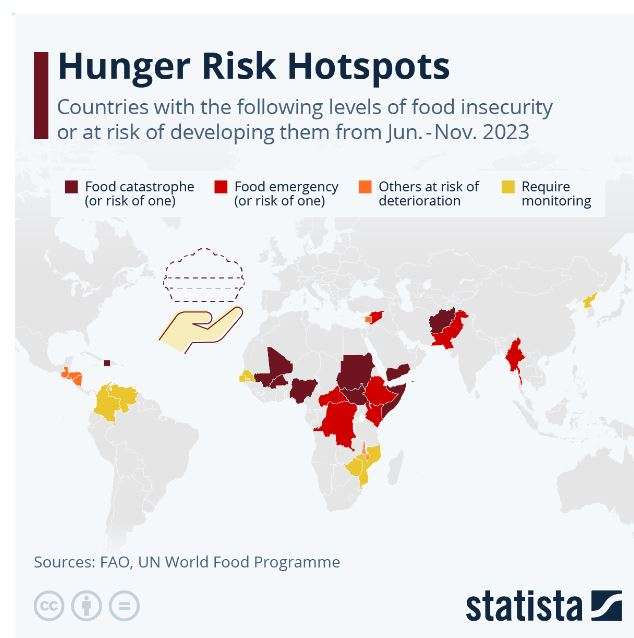The UN’s latest Hunger Hotspots report highlights the countries where substantial parts of the population are experiencing severe food insecurity and where this is at risk of deteriorating further.
As Statista’s Katharina Buchholz reports, the report sees the biggest problems or the risk of their development – defined as food catastrophe or the lack of food after all coping strategies have been exhausted – in Africa’s Sahel Zone (Burkina Faso, Mali) as well as in Nigeria, Sudan, South Sudan, Somalia, Yemen, Haiti and Afghanistan.
You will find more infographics at Statista
A cluster of factors, which for most countries consist of a combination of economic shocks, conflict and insecurity as well as displacement and natural catastrophes, was identified by the UN as the cause of severe food insecurity.
Food emergency and the risk thereof was found in other parts of Africa – namely in Ethiopia, Kenya, the Central African Republic and the Democratic Republic of the Congo – as well as in Syria, Pakistan and Myanmar.
It is defined as the stage of food insecurity in which households are using up their last resources, like selling belongings, to cope with gaps in their food supply. Other countries with acute food security issues that are deteriorating can be found in Central America.
On top of them, the UN has place a handful of countries on a monitoring list, mostly because of a lack of data.
These countries include several more in Africa, Venezuela and Colombia (where Venezuelan out-migration is causing issues) and also North Korea. In the course of the Covid-19 pandemic, the latter country has once more limited the movement of any people or goods across its borders to a minimum, also restricting the flow of information about the condition of its population.
There have been reports, however, about acute lack of food and starvation deaths in the country, most recently by ways of a BBC report secretly gathering interviews in North Korea.
After a devastating famine which is suspected to have killed around 3 million in the 1990s, the country had opened its borders to food and other shipments, which created the possibility of informal trade and smuggling in the tightly controlled regime and allowed people to satisfy their needs on the black market to a higher degree. With the border once again controlled very tightly, North Koreans have been reported to lack food as well as the income to buy it as avenues to gain money outside of official channels have been largely exhausted. Radio Free Asia reported based on accounts of North Korean officials that violence against police attempting to extract bribes was increasing in the country as citizens are fighting tooth and nail for scare resources.








